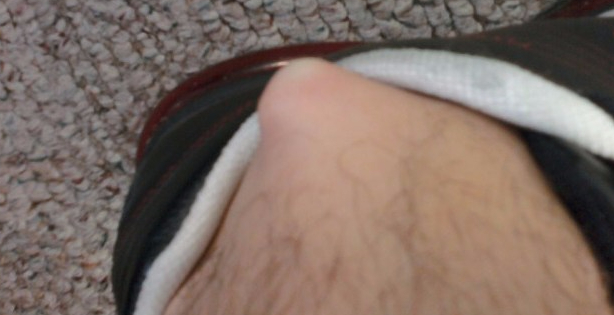Have Arthritis and/or Crohn’s Disease? Here are 5 Helpful Tips For Working Out
“A wise man should consider that health is the greatest of human blessings, and learn how by his own thought to derive benefit from his illnesses.”
― Hippocrates
While Crohn’s Disease and Arthritis have no known cures, there are several benefits that exercising regularly can provide for someone with chronic health conditions. Here are my top 5 tips for exercising with Crohn’s Disease and Arthritis:
1. Check With Your Doctor Before You Start
-Before you start your new workout regimen always check with your doctor to make sure you are healthy enough for exercise. I can’t emphasize how important this is, as you might be on a medication that makes you prone to lightheaded and/or dizziness which could possibly lead to a serious injury. Or maybe your body just might not be ‘healthy’ enough yet to start working out. Don’t stress over this and work with your doctor and medical team to create a target date to where you can begin a workout regimen.
Remember; always listen to your doctor’s advice. It’s not worth working out if it could further worsen your health.
2. Always Listen To Your Body!
-Now that you’ve checked with your doctor and you’re all clear to start working out, it’s important to listen to your body as you work out. If something hurts or doesn’t feel right then don’t do it! It’s important to push yourself, but be careful not to overdo it!
If you are like me and have severe arthritis in your ankles and other joints, then it’s probably best if you stay off of the treadmill and away from other high-impact workouts. There is almost always a substitute for a high-impact workout. For example, if you are working on cardio instead of running/jogging/walking on a treadmill try swimming. Swimming is a great cardio workout that will target your entire body while building endurance! If getting in the pool isn’t your thing, try cycling. Just be careful not to add too much resistance!
3. Work Hard, But Work Smart. Your Body Needs It
-Unfortunately, the odds are pretty high that your body isn’t in the best shape due to your chronic health conditions. Don’t worry, remember Rome wasn’t built in a day and neither will your body be. If your body allows it try your best to workout 3x-5x per week. Always allow your body sufficient time to rest.
I’ve found the best way to start my workout is by doing a light cardio warm up (usually cycling). This allows my body to get loose and ready for a more strenuous workout. I always vary my workout so I don’t work out the same body group more than 1x per week. This lets my body rest and reduces my chances for injury. For example, on Monday’s I will work out my chest muscle group. It’s easy to find workouts modified for people with Arthritis and/or Crohn’s by doing a simple Google search. Or you can talk to your gym and find a personal trainer who has experience helping people with Crohn’s Disease and/or Arthritis get a safe and effective workout.
Since you’re now burning up more calories, carbohydrates, and etc. it’s important your nutrition is helping you achieve what you want to accomplish. In addition to eating healthy, consider adding a protein supplement to help your body recover. I use Nature’s Best Isopure Natural Chocolate, it’s free from artificial sweeteners, gluten, and lactose all while providing 50 grams of protein, amino acids, and an amazing taste. If you’re interested, here’s a link describing the protein: http://www.theisopurecompany.com/product/isopurenatural.html As always, talk to your doctor before adding any nutritional supplements.
4. Go Light And Easy On Flare Up Days
It’s given that some days will be harder than others. If you start having a flare up it’s important to take it easy and not overdo it at the gym. If you’re having a severe flare up then it’s probably best to stay at home and rest instead of trying to muscle out a workout.
If you are feeling well enough to go to the gym while have a mild flare up, make sure to modify your workout so it doesn’t exacerbate your flare up. For example, if you usually do 30 minutes of cardio, consider reducing your cardio to only 10 minutes of light cardio. If you like to lift weights, use a much lighter weight than you are supposed to and increase the repetitions.
If you’re having an arthritis flare up, make sure you are doing a workout that will not cause damage to your joints.
5. Enjoy The Workout “High”
It’s not easy working out and sticking to a regimen, but as you do make sure you take the time to enjoy it. Measure your progress and celebrate it! If you lose an inch off your waistline or gain an inch around your biceps make sure you acknowledge the progress you’re making!
As you start to work out every day you should start to notice both physical and emotional benefits. After working out your body releases endorphins which make you feel great! After a couple of weeks at the gym you’ll start notice small changes: like you’re stronger, you have more energy, and etc.! As you continue working out your body will continue getting stronger and better each day!
An under-rated benefit of going to the gym on a continuous basis is that you’re likely to meet other people who might have the same conditions as you and are also trying to become healthier. It’s always helpful to have friends and support group that can help motivate you to reach your goals, especially when you’re having an off-day. Make friends and help each other achieve your respective goals. Studies show working out with a friend can actually increase the likelihood of you reaching your goals while reducing the chances you’ll quit to just 6.3%* So go ahead, make friends and achieve your goals!
If you have a helpful tip for working out with Crohn’s Disease and/or Arthritis let me know in the comments. If there’s something more you would like to know about my workout routine, let me know and I’ll do my best to answer it. As always this blog is not intended for medical advice. Always consult with your doctor before changing your lifestyle. Thanks for reading, and leave me a comment and let me know what you think!
*http://blog.codyapp.com/2013/07/30/workout-partner-motivation-exercises/















